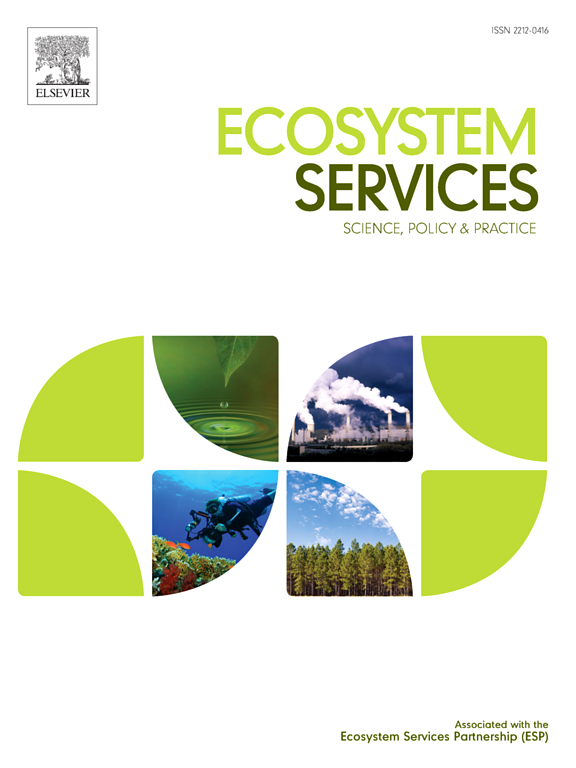Combination of participatory mapping and Maxent model to visualize the cultural ecosystem services at county scale
IF 6.6
2区 环境科学与生态学
Q1 ECOLOGY
引用次数: 0
Abstract
Cultural ecosystem services (CESs) evaluation is the key to comprehensively understand and evaluate ecosystem services. Spatial mapping of CESs can provide visual information for ecosystem management. The combination of participatory mapping and Maxent model helps to extend place-based spatial assessment of CESs to the regional scale. In this study, representative samples were obtained through participation mapping method, and the Maxent model was used to realize the spatial mapping of six types of CESs in Mizhi County based on environmental variables, and the influence of environmental variables on the spatial distribution of CESs was analyzed. The results showed that the Maxent model was robust for CESs spatial mapping at county scale. The spatial distributions of six types of CESs in Mizhi County had similar regularity, the high-values were concentrated along the Wuding River and its east–west tributaries, the median and low-values spread to the periphery along the high-value areas successively, but the area proportions of different grades of different types of CESs were different. Moreover, the spatial distribution of different CESs had overlapping areas, 62.62% of the areas had two or more types of CESs. In terms of the impact of environmental variables on the spatial distribution of CESs, the distance to residential areas had the largest contribution rate to all CESs, ranging from 35.88% to 67.37%. The remaining variables had different contribution rates to different CESs, and the distribution probabilities of CESs changed with the change of environmental variable parameters. This study can provide a reference for the spatial mapping of CESs at the regional scale, and promote the incorporation of CESs research into decision-making.
参与式制图与Maxent模型相结合的县域文化生态系统服务可视化研究
文化生态系统服务功能评价是全面认识和评价生态系统服务功能的关键。生态系统空间映射可以为生态系统管理提供可视化信息。参与式制图与Maxent模型的结合有助于将基于地点的CESs空间评价扩展到区域尺度。本研究通过参与作图法获取代表性样本,利用Maxent模型实现米脂县6类CESs基于环境变量的空间作图,分析环境变量对CESs空间分布的影响。结果表明,Maxent模型对县域尺度的CESs空间映射具有较强的鲁棒性。米脂县6种类型CESs的空间分布规律相似,高值区沿武定河及其东西支流集中,中低值区沿高值区依次向周边扩散,但不同类型CESs不同等级的面积占比不同。不同类型经济用地的空间分布存在重叠区域,62.62%的区域存在两种及两种以上的经济用地类型。从环境变量对CESs空间分布的影响来看,到居民区的距离对所有CESs的贡献率最大,为35.88% ~ 67.37%。其余变量对不同CESs的贡献率不同,CESs的分布概率随环境变量参数的变化而变化。本研究可为区域尺度上的生态环境空间制图提供参考,促进生态环境研究与决策的结合。
本文章由计算机程序翻译,如有差异,请以英文原文为准。
求助全文
约1分钟内获得全文
求助全文
来源期刊

Ecosystem Services
ECOLOGYENVIRONMENTAL SCIENCES&-ENVIRONMENTAL SCIENCES
CiteScore
14.90
自引率
7.90%
发文量
109
期刊介绍:
Ecosystem Services is an international, interdisciplinary journal that is associated with the Ecosystem Services Partnership (ESP). The journal is dedicated to exploring the science, policy, and practice related to ecosystem services, which are the various ways in which ecosystems contribute to human well-being, both directly and indirectly.
Ecosystem Services contributes to the broader goal of ensuring that the benefits of ecosystems are recognized, valued, and sustainably managed for the well-being of current and future generations. The journal serves as a platform for scholars, practitioners, policymakers, and other stakeholders to share their findings and insights, fostering collaboration and innovation in the field of ecosystem services.
 求助内容:
求助内容: 应助结果提醒方式:
应助结果提醒方式:


